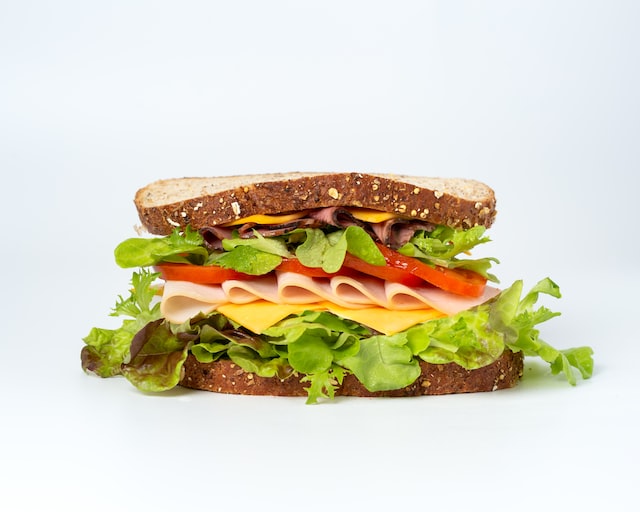A sandwich is typically defined as a dish consisting of two slices of bread with a filling between them, although there are many variations on this basic theme. A burger, on the other hand, is a sandwich that typically consists of a hamburger patty (or another type of cooked meat) and various condiments, sandwiched between two buns.
The difference between sandwiches and burgers
If you consider a sandwich to simply be any dish consisting of two slices of bread with something in the middle, then a burger would certainly qualify as a sandwich. However, if you consider a sandwich to be a dish in which the bread is merely a vessel for the filling and not an integral part of the dish itself (as is often the case with open-faced sandwiches), then a burger would not technically be classified as a sandwich.
Let us look at some of the key differences of the two, considering the difference in the:
The Bread
One of the most obvious differences between a sandwich and a burger is the bread. Sandwiches are typically made with two slices of bread that are used to contain the fillings, whereas burgers are made with a single round piece of bread, known as a bun. The type of bread used for both can vary, but the key difference is the number of slices.
The Fillings
Another key difference between sandwiches and burgers is the fillings. Sandwiches can be filled with a variety of ingredients, including meats, vegetables, cheese, spreads, and condiments. The fillings are typically layered on top of each other, with each ingredient adding its own unique flavor and texture to the sandwich. In contrast, burgers are typically filled with a single patty of ground meat, along with cheese, lettuce, tomato, pickles, onions, and condiments. While the fillings of a burger are more limited than those of a sandwich, they are designed to complement each other, creating a delicious and cohesive meal.
The Cooking Method
The cooking method used to prepare sandwiches and burgers is also different. Sandwiches are typically made by toasting the bread, or heating it up on a pan, and then filling it with the ingredients. In contrast, burgers are typically grilled or fried, cooking the patty and the bun at the same time. This gives burgers a distinct, juicy flavor and crispy texture that is difficult to achieve with a sandwich.
The Serving Method
The way that sandwiches and burgers are served is also different. Sandwiches are typically served cold, or at room temperature, and are often cut in half for easier eating. Burgers, on the other hand, are typically served hot, and are often served in their entirety. This allows the burger to be eaten with both hands, which is a key part of the burger-eating experience.
The Cultural Significance
In addition to their differences in ingredients, cooking method, and serving method, sandwiches and burgers also have different cultural significance. Sandwiches have a long history, dating back to the 17th century, and have been a staple food in many cultures around the world. In contrast, burgers are a relatively recent invention, first appearing in the United States in the late 19th century. Despite this, burgers have become an iconic American food, symbolizing American culture and the American way of life.
The Taste
Of course, one of the biggest differences between sandwiches and burgers is the taste. While both are delicious, they have distinct flavors that set them apart from each other. Sandwiches have a more complex flavor, with each ingredient adding its own unique flavor to the sandwich. In contrast, burgers have a simple, yet satisfying flavor, with the patty and the toppings working together to create a delicious meal.
Types of sandwiches
(Photo by Mae Mu on Unsplash )

There are two main types of sandwiches: Open–faced and Closed–faced.
Open–faced sandwiches have one slice of bread with toppings on top, while closed–faced sandwiches have two slices of bread with the toppings in between.
The most common type of sandwich is the closed-faced sandwich. The most common fillings for closed-faced sandwiches are meat, cheese, and vegetables. Meat can include deli meats such as ham, turkey, or chicken, as well as cooked meats such as burgers or pulled pork. Cheese can be sliced cheese, shredded cheese, or melted cheese. Vegetables can be anything from lettuce and tomatoes to onions and pickles.
Open-faced sandwiches are not as common as closed-faced sandwiches, but they are just as easy to make. The most common type of open-faced sandwich is the grilled cheese sandwich. Grilled cheese sandwiches are made by buttering one side of a slice of bread and then placing it butter-side down in a skillet. One or more slices of cheese are then placed on the unbuttered side of the bread and another slice of bread is placed on top, butter-side up. The sandwich is then grilled until the bread is golden brown and the cheese is melted.
There are endless possibilities when it comes to making sandwiches. Whether you choose to make a simple PB&J or a more complex grilled cheese with bacon and avocado, there’s a sandwich out there
Types of burgers
(Photo by amirali mirhashemian on Unsplash )

Burgers come in a variety of types and styles, each offering a unique blend of flavors and textures. Some of the most popular types of burgers include classic beef burgers, turkey burgers, veggie burgers, and lamb burgers. For those who enjoy a spicy kick, there are also spicy burgers made with jalapenos or hot sauce. Some burgers feature additional ingredients like bacon, cheese, avocado, and eggs, while others are topped with exotic condiments like wasabi mayo or pesto. There are also gourmet burgers, which are made with premium ingredients like Kobe beef or truffle oil, and served at upscale restaurants. Whether you prefer a classic, simple burger or one that is loaded with toppings, there is a burger to suit every taste and preference.
The term “burger” can also refer to the meat patty on its own, especially in the United Kingdom where the term “patty” is rarely used. The word “burger”, derived from the German word “Burg”, meaning “fortified town” or “castle”, first appeared in English in the early 19th century.
Why is a burger not called a sandwich?
While both burgers and sandwiches are made with bread and other ingredients, there are some key differences between the two. For one, a burger is typically made with a beef patty, while a sandwich can be made with any type of meat or even vegetables. Additionally, burgers are usually served with condiments like ketchup and mustard, while sandwiches are often served with mayonnaise or other spreads. Finally, burgers are typically cooked on a grill or in a frying pan, while sandwiches are usually assembled cold.
Is sandwich and burger junk food?
It depends on the ingredients and preparation methods used. Sandwiches and burgers can be made with wholesome, nutritious ingredients such as whole grain bread, lean proteins, and fresh vegetables, making them a healthy choice. However, many commercial versions of sandwiches and burgers are high in calories, unhealthy fats, salt, and processed ingredients, which can contribute to poor health if consumed regularly. Whether a sandwich or burger is considered junk food also depends on personal and cultural definitions of healthy eating and the context in which they are consumed. In general, it’s important to make informed choices and balance occasional indulgences with a diet that is rich in whole, nutritious foods.
How to make sandwiches and burgers healthy?
Here are some ways to make sandwiches and burgers healthier:
- Use whole grain bread: Opt for whole grain bread instead of white bread, as it provides more fiber and nutrients.
- Choose lean protein: For burgers, select lean ground beef or ground turkey. For sandwiches, opt for lean deli meats like turkey or chicken breast.
- Load up on vegetables: Add plenty of fresh vegetables like lettuce, tomatoes, onions, and avocado to your sandwich or burger.
- Limit high-calorie condiments: Use condiments sparingly, or opt for healthier options like mustard, salsa, or hummus instead of mayonnaise or cheese.
- Bake or grill instead of frying: Cooking your burgers or sandwiches by grilling or baking rather than frying reduces the amount of unhealthy fat in your meal.
- Control portion size: Be mindful of the portion size of your sandwich or burger and consider pairing it with a side salad or fruit to help balance your meal.
By incorporating these tips, you can make your sandwiches and burgers healthier and still enjoy the flavors you love.
Is pizza a type of sandwich?
No, pizza is not considered a type of sandwich. A sandwich typically consists of two slices of bread with filling in between, while pizza is a flatbread typically topped with sauce, cheese, and other ingredients. The definition of a sandwich typically requires the use of two separate slices of bread, which distinguishes it from other foods like pizza, wraps, and tacos. Although some may argue that a stuffed crust pizza or calzone could be considered a type of sandwich, these are generally considered unique dishes in their own right.
Is a hotdog a sandwich or a burger?
A hotdog is not considered a sandwich or a burger. A hotdog is a type of sausage that is typically served in a bun, but it is distinct from both sandwiches and burgers. A sandwich typically consists of two slices of bread with filling in between, while a burger is typically a patty of ground meat served on a bun. While the hotdog and its bun may resemble a sandwich, it is not considered as such due to the unique preparation and ingredients involved. Hotdogs have their own unique taste, ingredients, and cultural significance, and are considered a distinct type of food.
The Advantages and Disadvantages of sandwiches
When it comes to a sandwich vs burger debate, it really depends on what you’re looking for. If you want something quick and easy, then a sandwich is probably your best bet. However, if you’re looking for something more filling and satisfying, then a burger is probably what you’re after. Here’s a look at the advantages and disadvantages of both sandwiches and burgers:
Advantages of sandwiches:
- They’re quick and easy to make
- You can customize them with your favorite toppings
- They’re portable and easy to eat on the go
- They’re usually less messy than burgers
Disadvantages of sandwiches:
- They can be boring if you don’t get creative with your toppings
- They’re not as filling as burgers
- Some sandwich bread can be dry or bland
The Advantages and Disadvantages of burgers
There are many advantages and disadvantages to burgers. One advantage is that they are usually very filling and satisfying. Another advantage is that they can be made with a variety of different ingredients, so you can customize your burger to suit your taste. A disadvantage of burgers is that they are often high in fat and calories, so they should be eaten in moderation. Another disadvantage is that if not cooked properly, burgers can be greasy and unhealthy.
Overall, the advantages and disadvantages of burgers depend on the ingredients and preparation methods used. Opting for homemade burgers made with lean protein and wholesome ingredients can provide a healthy and satisfying meal, while limiting consumption of fast food burgers can reduce the risks associated with processed foods.
Advantages of burgers:
- Convenience: Burgers are widely available and easy to prepare, making them a popular choice for quick and convenient meals.
- Versatility: There are many different types of burgers, from classic beef to veggie and turkey burgers, allowing for a variety of flavors and ingredients.
- Affordability: Burgers are often less expensive than other types of food, making them a budget-friendly option for many people.
- Social appeal: Eating burgers is often associated with social activities like barbecues and picnics, making them a fun food to share with friends and family.
Disadvantages of burgers:
- Nutritional value: Many burgers, especially those from fast food restaurants, are high in calories, unhealthy fats, and salt, which can contribute to weight gain and health problems.
- Processed ingredients: Many commercial burgers contain processed ingredients like preservatives and additives, which can be harmful to your health if consumed regularly.
- Environmental impact: The production and consumption of burgers can have a negative impact on the environment, due to the resources required to raise livestock and the waste generated by fast food restaurants.
Featured Image By – Photo by Jakub Kapusnak on Unsplash








